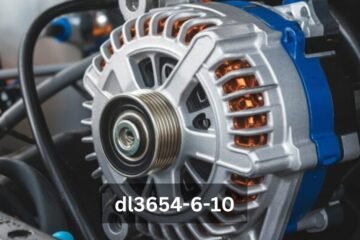Encountering the P1326 diagnostic trouble code (DTC) can feel overwhelming, especially if you’re unfamiliar with the technical aspects of vehicle diagnostics. This code is specifically associated with Hyundai and Kia vehicles, signaling an issue with the Knock Sensor Detection System (KSDS). While the check engine light may be the first indicator, the underlying causes and solutions for the P1326 code require a deeper understanding of the components involved. This comprehensive guide will walk you through the symptoms, causes, severity, diagnostic process, and fixes for the P1326 code, ensuring you’re equipped to handle this issue confidently and effectively.
What Does the P1326 Code Mean?
The P1326 code relates to the detection of abnormal engine vibrations caused by pre-ignition or detonation, also referred to as engine knocking. These vibrations are identified by the Knock Sensor Detection System (KSDS), a critical component designed to prevent severe engine damage. When this system detects unusual patterns, it triggers the P1326 code and often activates “limp mode,” a safety feature that limits engine power to reduce the risk of catastrophic failure. This protective measure underscores the importance of promptly addressing the issue.
The KSDS serves as a safeguard for your engine’s health. By identifying pre-ignition or detonation, it prevents conditions that could lead to permanent damage, such as connecting rod bearing wear or even total engine failure. Understanding the role of the KSDS helps contextualize the seriousness of the P1326 code and highlights why addressing it is not just about resolving a warning light but ensuring the longevity and performance of your vehicle.
Symptoms of the P1326 Code
When the P1326 code is triggered, your vehicle typically exhibits several symptoms that can hinder its drivability and performance. The most common sign is the illumination of the check engine light on your dashboard, a clear warning that something is amiss. In addition, the vehicle may enter limp mode, a state that restricts engine power and speed. While this feature is designed to prevent further damage, it can significantly impact your ability to drive the vehicle effectively.
Other symptoms include poor acceleration, reduced fuel efficiency, and increased engine vibration. These issues can make daily driving uncomfortable and, in some cases, unsafe. Left unchecked, the problems associated with the P1326 code can worsen, potentially leading to engine overheating, additional mechanical failures, and higher repair costs. Recognizing these warning signs early allows you to address the issue before it escalates.
Causes of the P1326 Code
Several factors can contribute to the P1326 code, ranging from relatively simple fixes to more complex mechanical issues. One of the most common causes is a faulty knock sensor. This component is integral to the KSDS, as it detects engine vibrations and relays information to the Engine Control Module (ECM). If the sensor is damaged or malfunctioning, it may send inaccurate data, triggering the P1326 code.
Wiring and connection issues are another frequent culprit. Damaged or loose wiring between the knock sensor and the ECM can disrupt communication, leading to false readings and unnecessary error codes. Similarly, problems within the ECM itself, such as outdated software or internal malfunctions, can contribute to the P1326 code. In more severe cases, mechanical failures, such as connecting rod bearing wear, may be the underlying cause. These issues require immediate attention, as they can result in catastrophic engine damage if left unaddressed.
Is It Safe to Drive with the P1326 Code?
Driving with the P1326 code active is not recommended, as it often places the vehicle into limp mode. While this safety feature allows you to drive the vehicle to a repair facility, it restricts engine power to prevent further damage. Prolonged use in this state can exacerbate underlying issues, leading to more extensive and costly repairs.
Ignoring the P1326 code can have serious consequences. Persistent engine knocking or detonation can cause significant damage to internal components, such as pistons and bearings. Over time, these issues may necessitate a complete engine overhaul or replacement, both of which are costly and time-consuming. Addressing the P1326 code as soon as it appears is the best way to avoid these long-term complications and ensure your vehicle remains in optimal condition.
Diagnosing the P1326 Code
Diagnosing the P1326 code requires a systematic approach and the right tools. An OBD2 scanner is essential for retrieving the code and identifying associated error messages. Begin by connecting the scanner to your vehicle’s diagnostic port and recording the codes displayed. Once you’ve confirmed the P1326 code, you can move on to inspecting specific components.
The next step is to examine the knock sensor and its wiring. Look for signs of damage, corrosion, or loose connections that could interfere with the sensor’s operation. Use a multimeter to test electrical continuity and ensure all connections are secure. If no issues are found with the sensor or wiring, the focus should shift to the ECM. Verify that the software is up to date and check for any signs of internal malfunction. By following these steps, you can accurately diagnose the cause of the P1326 code and determine the appropriate course of action.
How to Fix the P1326 Code
Resolving the P1326 code typically involves addressing the root cause identified during the diagnostic process. If the issue lies with the knock sensor, replacing it is often the most effective solution. This task can be performed by experienced DIYers with access to a repair manual and the necessary tools. However, for wiring issues or ECM-related problems, professional assistance is strongly recommended.
Repair costs for the P1326 code can vary depending on the specific issue. Replacing a knock sensor typically costs between $150 and $400, while wiring repairs may range from $100 to $500. ECM reprogramming or replacement is more expensive, with costs falling between $200 and $800. While these repairs represent an investment, addressing the P1326 code promptly can save you from even more costly engine repairs in the future.
Preventing the P1326 Code
Preventing the P1326 code requires proactive vehicle maintenance and vigilance. Regularly inspecting your vehicle’s wiring, sensors, and engine components can help identify potential issues before they escalate. Additionally, staying up to date with ECM software updates is crucial, as manufacturers often release updates to improve system performance and address known issues.
Recognizing early warning signs, such as unusual engine noises or a lit check engine light, allows you to take immediate action and prevent more significant problems. Establishing a routine maintenance schedule that includes thorough inspections and timely repairs is the best way to minimize the risk of encountering the P1326 code and other related issues.
Case Studies: Real-Life Examples of P1326 Fixes
Many Hyundai and Kia owners have successfully addressed the P1326 code, each with unique experiences that offer valuable insights. For instance, one Hyundai Sonata owner noticed a sudden loss of engine power while driving, accompanied by the check engine light. Upon using an OBD2 scanner, the P1326 code was identified. After inspecting the vehicle, the issue was traced to a faulty knock sensor. Replacing the sensor and updating the ECM software resolved the problem, restoring the vehicle to optimal performance.
In another case, a Kia Optima owner experienced the same code but faced a more complex repair process. The root cause was found to be damaged wiring between the knock sensor and the ECM. While the knock sensor itself was functional, the compromised wiring caused intermittent communication failures. A professional mechanic conducted a detailed inspection, repaired the damaged wiring, and ensured all connections were secure. The vehicle’s performance returned to normal, highlighting the importance of addressing all potential causes when diagnosing the P1326 code.
Resources for Dealing with the P1326 Code
Having access to the right tools and information can make diagnosing and fixing the P1326 code much easier. Essential diagnostic tools include an OBD2 scanner, a multimeter, and access to your vehicle’s repair manual. These tools empower you to accurately identify the cause of the code and determine whether it can be resolved through DIY efforts or requires professional intervention.
Online forums and communities dedicated to Hyundai and Kia vehicles are invaluable resources for learning from others’ experiences. These platforms often provide step-by-step guides, troubleshooting tips, and recommendations for trusted mechanics. Additionally, manufacturer resources, such as service bulletins and recall notices, can offer specific guidance for addressing the P1326 code in your vehicle model.
Encouragement for Proactive Maintenance
The P1326 code serves as a reminder of the importance of regular vehicle maintenance and early intervention. By staying informed about your vehicle’s systems and addressing issues as they arise, you can protect your investment and enjoy a reliable, efficient driving experience. Whether you’re a DIY enthusiast or prefer professional assistance, understanding the P1326 code equips you to take control of your vehicle’s health.
Remember, timely action not only prevents more significant problems but also saves money in the long run. With the knowledge and tools provided in this guide, you’re well-prepared to tackle the P1326 code and maintain the performance and longevity of your Hyundai or Kia vehicle.
Conclusion
The P1326 code is a warning that should not be ignored. While it may initially appear as a minor inconvenience, failing to address the issue promptly can lead to severe engine damage and costly repairs. By understanding the symptoms, causes, and solutions associated with the P1326 code, you can take the necessary steps to protect your vehicle and ensure its long-term performance.
Frequently Asked Questions
Can I clear the P1326 code myself?
While it’s possible to clear the code using an OBD2 scanner, this is only a temporary solution. The underlying issue must be resolved to prevent the code from returning and to avoid potential engine damage.
How much does it cost to fix the P1326 code?
Repair costs vary based on the cause. Replacing a knock sensor typically costs $150–$400, while wiring repairs or ECM reprogramming can range from $100 to $800. Complex mechanical repairs may cost more.
How do I know if my knock sensor is faulty?
A faulty knock sensor often causes symptoms such as the check engine light turning on, reduced engine performance, and increased fuel consumption. A diagnostic scan and multimeter test can confirm if the sensor is malfunctioning.
Stay in touch to get more updates & alerts on TubeGalore! Thank you



